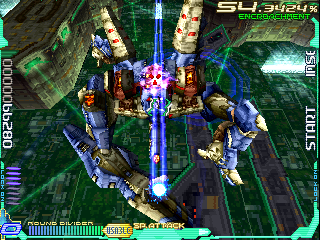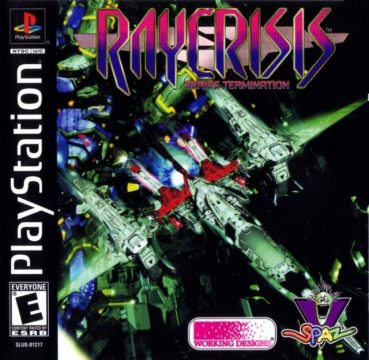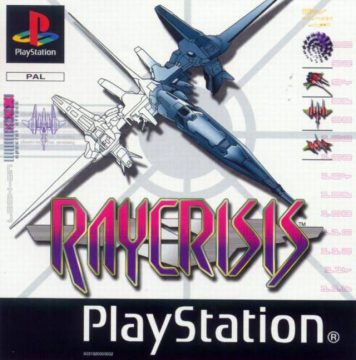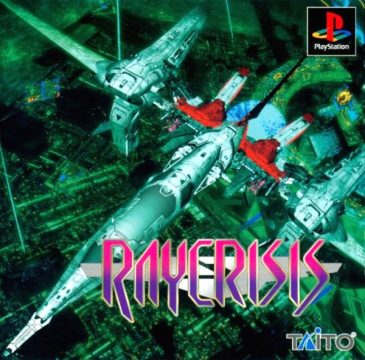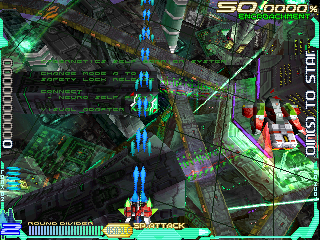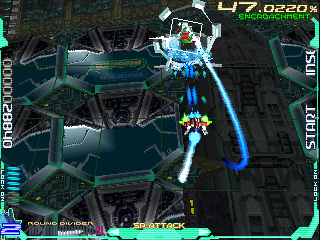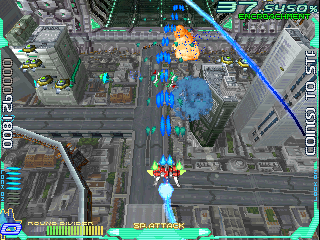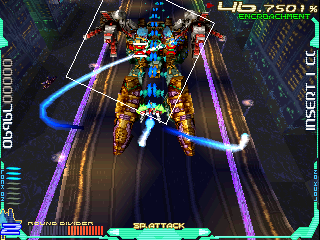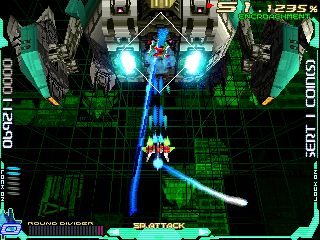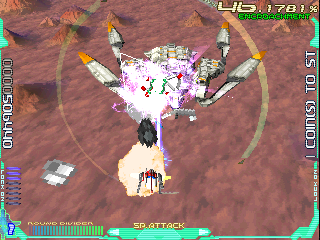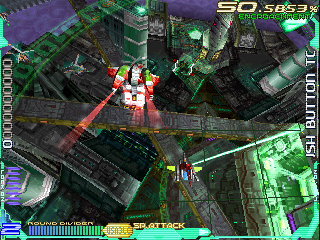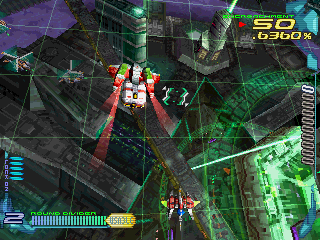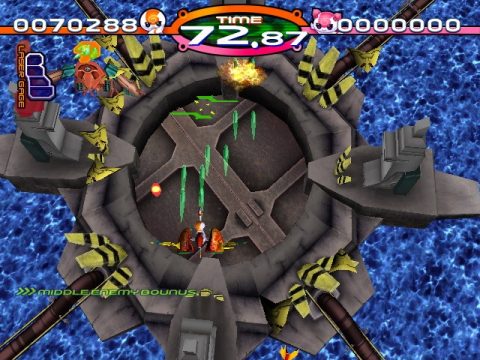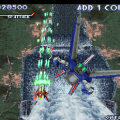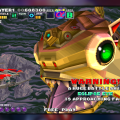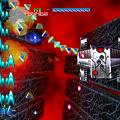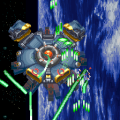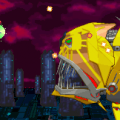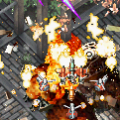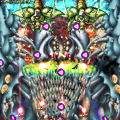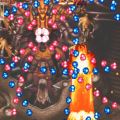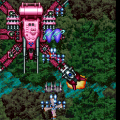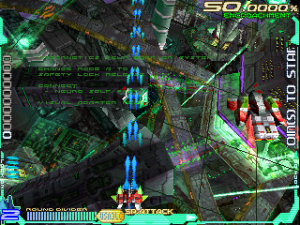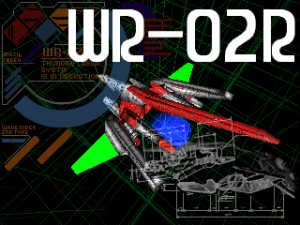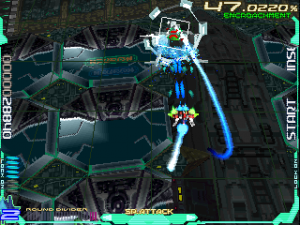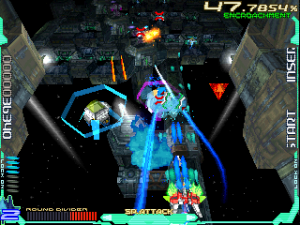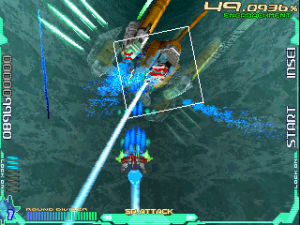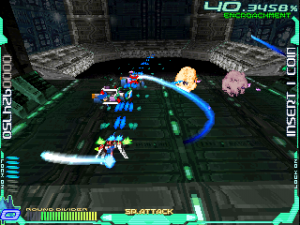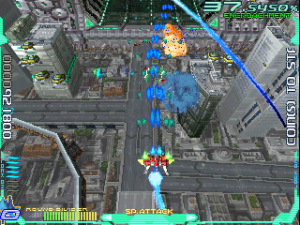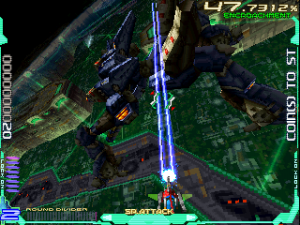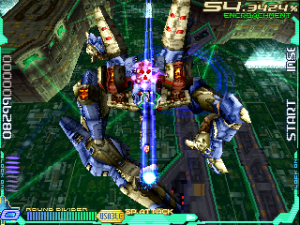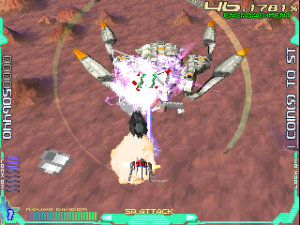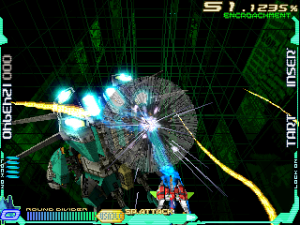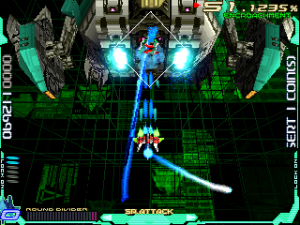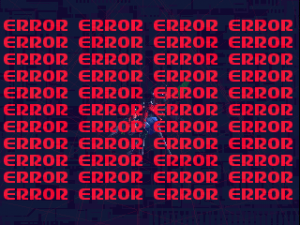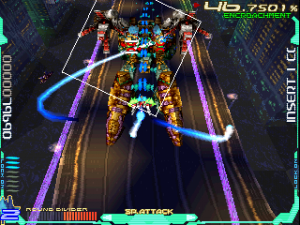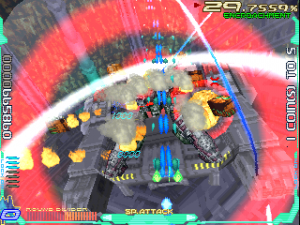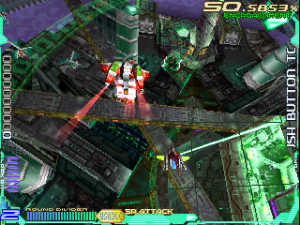- RayForce
- RayStorm
- RayCrisis: Series Termination
- Ray’z Arcade Chronology
The Ray- series has a morbidly fascinating backstory to it, light and understated though it may be. Granted, RayStorm did not get really grim until the ending, but RayForce started out under horribly dire circumstances in which the omnipotent AI, Con-Human, went murderously insane after a failed fusion with an artificial human. Taito decided to further explore the rise of Con-Human’s rampage by creating a prequel, RayCrisis, with the incredibly self-defeating subtitle of Series Termination.
It all starts out lovely enough with Con-Human already having lost its marbles and sending out armies to exterminate humans with the intent of creating “perfect” synthetic duplicates to “replace” them. While the Earth is demolished to be remade as Con-Human’s new corporeal form, a nameless cyberspace hacker launches a desperate assault to jack into the supercomputer’s virtual core and purge its corruption to cease its insanity. The hacker sends in viruses known as “Waveriders,” conveniently modeled to look like small starfighter ships that are able to destroy Con-Human’s defenses (manifested as mechanical foes called “antibodies”) by blowing the crap out of them. It is up to the Waveriders to keep the malicious AI from causing any more chaos than it already has; even if it could be too late, the least that can be done is to ensure that no more lives are lost in the real world by ending it in the digital realm.
Thus, RayCrisis is Taito’s spin on the whole “war in cyberspace” trope that has long been popular in geek culture since the advent of Tron. While this frame is somewhat apparent in the game’s design (particularly the first super-short intro level and the final boss area), it still looks and plays akin to the previous two games. Running on the Taito G-Net hardware (the same hardware for the shooter Psyvariar), it looks considerably nicer than RayStorm with smoother models and generally brighter and colorful landscapes.
The stages are a fair deal more varied in appearance, jumping through cityscapes, stormy skies, desert fields, giant water tunnels and the like. Everything is animated nearly seamlessly, and there is never any slowdown despite how hectic the action may get. While the sprite-based visuals of RayForce may be preferable to some, RayCrisis does at least look more attractive than RayStorm on the whole. Its sound design is also more notable in that it reaches some decidedly bizarre frontiers. The music tends to be a bit more subdued and atmospheric, more fitting to the mood of the current situation than providing a steady beat throughout any given stage in a sense somewhat akin to Einhander. It’s still some marvelous music to be sure, but it is a marked departure from the more typically space shooter style of the first two games.
How the game works is still very much like its older brothers: shoot everything that moves. The lock-on feature for which the series is known functions as it did in RayStorm, where enemies can be on the same plane as you and still be targeted. The various mechanical-looking virtual defense forces of Con-Human are known as “antibodies,” though they don’t look too different from any of the Secilian ships you’d find in RayStorm. You have two Waveriders to choose on the offset: The WR-01R, which behaves much like the R-Gray 1 from RayStorm, and the WR-02R, which acts akin to the R-Gray 2. The former has a straight cannon and lock-on lasers, and the latter uses a constant beam and electric bolts.
For all intents and purposes, these ARE the R-Grays from RayStorm, but they do have a couple slight differences in their design. Their Hyper Lasers have been revamped to fire powerful orange blasts which not only damage the prime target but also causes a splash effect which toasts smaller enemies around it. The new Special Attack, now known as the Round Divider, lasts shorter than RayStorm‘s screen clearer but seems to do more damage. The differences are subtle enough that they may as well be cosmetic, but a third ship can be unlocked, the unconventional WR-03, whose main attack is a stream of homing missiles which fly out every which way. Its lock-on attack is a photon chain gun which fires as fast as you can tap the button, and you can rack up an insanely high score if you keep a steady photon chain going. The WR-03 is good for pesky minor enemies but falters against larger antibodies due to its lack of strong weaponry and Hyper Laser capability. While experts only, the WR-03 is definitely the most unique playable craft in the trilogy, and it can be formidable if mastered.
While the gameplay is familiar, the overall structure to RayCrisis is decidedly unorthodox. Instead of being laid out as a straight level-after-level shmup as the previous two games, the levels you play here are randomly determined for each new playthrough. The actual game itself is only five levels long, and only the middle three are actually of regular length. The starter level, Self One, lasts for approximately one minute and throws no bosses at you. It is there to merely ease yourself into the game before embarking upon a sequence of three out of the following five stages: Memory, Consideration, Intelligence, Consciousness, and Emotion. These stages last about the duration of any of RayStorm‘s stages and hit you with big bad bosses (or “huge antibodies”) at the end of them, all of which are quite cool. The giant spider mech, Pro-Tor, is somewhat lazily the boss of two different levels, but it at least has a second form if you fight it later in the game.
It is also worth noting that regardless of what stage you pick, the difficulty always increases; each stage is tailored to include more enemies depending on whether it goes first, second, or third. After this stage trio, you go on to fight the final boss, the massive Dis-Human antibody, which is, in an interesting bit of continuity, very similar to the physical projection of Con-Human that served as the final boss to RayForce. Needless to say, it ain’t easy.
So RayCrisis is, by straightforward definition, quite short. A standard playthrough may only take about fifteen to twenty minutes, which is quite minimal even by shooter standards. However, the randomization of levels definitely gives it a boost in replay value, and its quick finishing time makes it easy to just pick up and play without getting too involved. There’s also the matter of the Encroachment gauge, a new system which is likely to baffle and intimidate newcomers. Beginning at 50%, the Encroachment counter keeps increasing on its own but decreases whenever enemies are wrecked. The larger the antibody, the more the Encroachment number drops, and efficiently and quickly defeating bosses can really help to size down the percent. The lower the Encroachment, the more points you score, but the higher it gets, the closer you risk an incredibly premature game closer. Failing to kill fast enough and letting the meter hit 100% causes the fight against Dis-Human to prematurely commence, and you get the bad ending after beating it, not to mention a reduced score as a result of a short game made even shorter. However, you get the bad ending even if you do reach Dis-Human in the time you are supposed to face it. In order to get the best ending, you need to have your Encroachment down by 20% or lower by the time you get to Dis-Human, which is a REALLY difficult feat to normally manage. This is the only way to reach the TRUE final boss: Infinity, Con-Human’s core and a real doozy to extinguish.
RayCrisis is a bit of an odd beast to judge, as its incredibly short length and somewhat controversial Encroachment mechanic may not appeal to everybody. Very few gamers are going to be good enough to get the Encroachment gauge low enough to summon Infinity and get the real ending. However, it is undeniably a great-looking shooter whose play mechanics are just as solid as its previous two entries, even if the changes made to its formula might not be appreciated by everybody. It is still recommended for any shooter fans and serves as both a suitable close to the series and a canon precursor to RayForce as the good ending exhibits.
Plus, it also has two player functionality and an odd stat-keeping system where the arcade processor can actually remember someone’s best scores. Before the game starts, it asks to input anyone’s three initials and a fourth letter/number/symbol which acts as their “security code.” Not only does the game remember your scores and progress, but it also brings up the stages played in any given play session and asks if you want to replay the exact three stages or change to another randomly-generated sequence. It’s a neat quirk that would be interesting to see on other shooters, though when RayCrisis was released, shmups were already on their way out, and it was one of the very last shmups Taito themselves developed. RayCrisis is something of a swan song for the big blue triangle, but they picked a good note to go out on for this genre.
Two years later, RayCrisis received a PlayStation release, though it was not quite as prominent as RayStorm due to its timing. It was released on the fringes of the PS1’s twilight as the PS2 was just coming into vogue, and the only recognizable company still making shoot-em-ups by that time was Cave. This is too bad, as the home translation of RayCrisis is arguably better than its arcade version.
Aside from coming with the obligatory console additions (difficulty adjust, sound test, art gallery), the game’s structure has been enhanced for the better. WR-03 is unlocked from the start, and you can now choose the three stages (out of five) that you wish to play, giving you more control of how you want to play the game instead of being at the mercy of chance. If you so wish, you may even choose the same stage twice or for all three times! The requirement to reach the true final boss has been made less ridiculous to boot: So long as Encroachment does not reach 100%, you can get to Infinity if you beat the rest of the game using five continues or less. It’s not easy, but it is certainly more manageable than dropping Encroachment below 20% and expecting it to stay by the time Dis-Human arrives.
There are also some other neat touches, like how you can select several colors for your Waverider from red, blue, yellow, or black using the shoulder buttons. Loading screens are normally a drag, but when they appear in this game, they actually fit really well with the cyberspace theme and make it feel as if you’re immersed in the great virtual highway. You even get loading screens before bosses that display their name in a touch likely borrowed by the Darius series. As a further bonus, you can unlock the R-Gray 1 and 2 from RayStorm as playable ships; while they function similar to the first two Waveriders, they have a few subtle differences which make them worth trying out.
The biggest addition to RayCrisis‘ Playstation version is the new “Special Mode,” which is a throwback to early ’90s PC Engine shooters like Super Star Soldier that would feature score attack modes. You only have one continue in Special, but to compensate, your ship is constantly at full power. Targets that normally toss out power-ups instead generate crimson spheres which lower your Encroachment gauge, as well as bonus lives that prolong your current score bender. To ensure that your run isn’t a total breeze, you must play EVERY stage back-to-back, including a new level called “Judgement” that serves as your final test before the end battles against Dis-Human and Infinity. Furthermore, your Encroachment meter fluctuates wildly and often risks coming close to 100%, though you only lose major score points if it does this. Regardless, it is in your favor to keep that gauge low by getting those bonus spheres.
The home port is mostly superior to the arcade save for two factors: The graphics look slightly less nice outside of its original arcade element (which is relatively trivial as it still looks attractive), and it does not have a two-player mode. This latter factor might be a problem for buds who enjoy co-oping on every shooter that allows it, but even if only one can enjoy the action, the home version feels like a richer package on the whole.
Screenshot Comparisons
In 2007, Taito released Furu Furu Park for the Nintendo Wii, a collection of minigames based on their classic arcade properties. Although not explicitly named after any of the Ray~ series, the game Swan Shooter borrows looks and plays almost identically to the series, so the homage is obvious. There are two variations, including a more difficult Night Strike variation. The stages are only a couple of minutes long, but they’re decent for caravan-style score attack runs, and overall it’s one of the better games on the collection.
